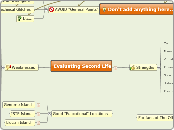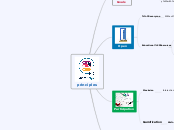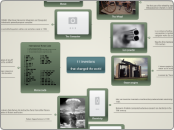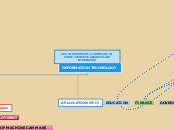For fans of The Office
http://www.youtube.com/watch?v=U3d_fqDcN1s
Very Good!(Patrick G.)
Chuck
Hilarious! I love it...
Good "Educational" Locations
Elucian Island
A place to hear lectures and podcasts. Also links to scientists' websites.
ISTE Island
Awesome resource for educational technology.
Some "highlights":
-"Social" times to interact with fellow educators
-Podcaster's Place
-Blogger's Hut
-Emerging Technologies ideas Library
-and many more...
Resources found at Podcaster's Place:
A podcast about podcasting!
http://www.podcastingunderground.com/
Tips for Listeners from Apple!
http://www.apple.com/itunes/store/podcaststips.html
Podcasting 101
http://www.imediaconnection.com/content/7184.asp
Ten Tips for Improving Your Podcasts
http://digitalmedia.oreilly.com/2005/08/10/improvingpodcasts.html
Scottmerrick Oh's del.icio.us from his NECC 2007 Windows Podcasting Tools, Tips, and Strategies for Success session NECC2007
http://del.icio.us/scottmerrick
Genome Island
Information galore!
I actually walked in a cell...it was pretty cool.
The "main" areas on this island are:
-Gene Pool
-Abbey (walk where Gregor Mendal walked...)
-Terrace
-Tower (loads of info)
This resource has a lot of potential for learning about genetics, etc.
Don't add anything here...just a reminder!!!
AVOID "General Points"
Etc...
Technical Glitches
Problems with Strangers
Evaluating Second Life
This week, we focus on Second Life.
What is Second Life?
http://secondlife.com/whatis/?lang=en-US
Starting Second Life (it is free to join)
Go to SecondLife.com
Download and install, open Second Life
Begin to explore. Plan on exploring over a few days, at least.
(note: I spent a couple hours exploring SL. It was a bit frustrating for me because I couldn't do many of the things I wanted to do. Clearly, exploration and learning about SL takes a while. Have patience)
Wired Travel Guide: Second Life
http://www.wired.com/wired/archive/14.10/sloverview.html
Discussion Focus: As a potential learning experience, what are the particular strengths and weaknesses of Second Life? It is easy to come up with general points - the problems of interacting with strangers, technical glitches, and so on. Avoid those issues because they're really not that interesting. Furthermore, one really doesn't have to know Second Life all that well to make those points. Instead, take time to get to know Second Life. Think about it from a student or teacher's perspective. Then, come up with a few points that are really specific to your own experiences in SL, to your own experiences as a student or teacher.
Weaknesses
How do we know if the creator(s) of each world is legitamate? (Erica)
Real Learning? (Erica)
I wonder if Second Life is interactive enough for real learning to take place. For example, I teleported to Spain and other users were speaking in Spanish (and swearing in English), but I certainly don't feel like I truly experienced Spain.
Are there enough worlds that are educational enough to provide opportunities for new knowledge acquisition?
Unreal (Patrick G.)
Though the newness of the experience visiting Second Life was sort of cool, the relity of the sites left something to be desired.
One example was the "Arc de Triomphe". Very strange and totally unlike Paris in any way. I don't know what possible educative use it would have.
Compared to... (Chuck)
To be the devil's advocate...
Does it create something more "real" than a picture in a book...and simply talking about it?
Educative Value? (Patrick G.)
I visited many worlds on Second Life, but I didn't find anything very useful to my teaching practice, yet. I have to admit there are many, many places I have not visited so far.
The one cool place that seemed promising- the NASA island, had a space shuttle and a lunar lander you could enter and check out, but it was very limited and poor optical quality. I didn't see what I could do with it aside from offering a little novelty.
Making your own world in Second Life might be good for teaching, but I suspect the commitment of time and energy might stop me from ever going there.
Searching (Chuck)
I agree. But, there are numerous educational locations. The bad part is that they are hard to find...at least for novices like ourselves...
Complicated (Patrick G.)
The learning curve on Second Life feels very steep to me. You have to spend a lot of time and energy to become proficient. I teach a t a school that does trimesters- 12 weeks equates to a semester at a traditional school. I don't see me spending that precious time training students to use a tool of limited educative use (at least so far it's been limited from my viewpoint).
I can see the use of making my own world (or island or whatever we call them) for my students, but it looks like a huge undertaking, and I think you also have to actually buy the land used. I know I can't do it right now- maybe a summer project? I'll need more value than I've seen to attempt this.
Too much down time? (Erica)
Patrick,
I was about to write a unique post on the steep learning curve of Second Life, but I read your note so I figured I would just respond to you.
With all subjects, especially science-based subjects, there is an issue of time. How will we have enough time to teach all of our content standards and teach them in a way that students understand. It's the whole depth vs. breadth issue with which we're all too familiar. It took me a good couple of hours to get somewhat familiar with Second Life and where I should go. Do we really have that much classroom time to devote to Second Life? Are the educational activities in Second Life worth it? Could we find a shorter simulation that serves the same purpose?
Along with a steep learning curve, I felt like there was too much unproductive time as I walked, ran, and flew to different places.
Ditto (Chuck)
It took me some time to navigate efficiently (and I'm still not very good).
Literally, I had to go to YouTube and type in "educational uses for Second Life" to lead me any where worth going...
Safety (Chuck)
As with any new technology (to me), I am a bit weary about students' abilities to wander...into areas that are not safe or appropriate. Yes, I can educate them on those types of situations...but it may still happen.
If I have students sign up for Second Life, what "control" do I have? Am I able to set up a "firewall" of sorts? It seems like a responsibility that makes me uneasy...
Teen Second Life (Patrick G.)
I dont' think there's a way to stop students from travelling wherever they'd like in Second Life, including the mature and adult only worlds.
We stop them from accessing types of sites at our school, by not allowing the server to connect them, but once you're in Second Life, you're in. I haven't checked, but my school server may not allow us to visit Second Life.
There are some controls- I went to Tombstone and they presented me with a list of rules that, broken, could have consequences, including being banned from the town. You also had to sign up with a group to participate, but that didn't stop you from visiting or talking to others in town. So there might be some potential control there- if you made your own class world, you could require pople to act appropriately and join a group to participate.
I believe Second Life can ban people from their web site completely if they act out in a harrassing manner, but that doesn't stop them from doing it before they're banned, does it?
In an article I read they mentionned Teen Second Life, which has more safety features but less available tools/resources. I plan to check it out.
Limited Controls (Erica)
In my explorations I couldn't find a way to limit a user's usage or traveling. I would be nervous that they would access mature content (during or outside of school hours).
Glorified Website? (Chuck)
As I toured ISTE Island, I came into contact with many "links"...either to the ISTE website, or something similar.
Is this just another way for students and teachers to get information?...with a "social twist"
Strengths
Pre-made Lessons (Erica)
On a visit to Genome Island I explored the dihybrid rabbit cross as well as a complementation cross. When I clicked on the available notecard I was able to read about the different alleles for rabbit coat color (some of which I did not know) and then there were 5-7 questions for each cross. Some of the questions were pretty simple, but others required students to apply some of their previous knowledge, which as we know is at a higher level of Bloom's Taxonomy. Even if a teacher didn't want to use the format of Second Life, perhaps they could borrow some of the questions that are available.
The pictures that went along with the questions were relevant and informative as well.
Historical Roleplaying (Patrick G.)
Another possible tool for helping students learn. There are many roleplaying opportunities set up with varying degrees of reality or history backing the environment. Maybe new ones could be created by teachers as well, ones that address exactly targeted content.
Social Interactions (Patrick G.)
The big strength of Second Life is it's social interaction capabilities. You can join or form groups of any delineation- teachers, hobbiest, historians, pet lovers, whatever, and interact with people of like interests anywhere in the world. Very powerful.
This aspect might be used for an educative purpose, with students meeting people such as accomplished writers, scientists, or other succesful people willing to interact over distance.
There could also be study groups or collaborative teams of students in this environment.
Professional Development (Chuck)
Areas like ISTE Island offer numerous opportunities to interact with fellow educators. This has incredible potential to allow sharing among educators from far-away distances. Never before has something like this been available.
Virtual Models (Chuck)
Interactive 3D models is a definate strength of Second Life. I was wowed and amazed when I dropped into an actual cell...and it didn't stop there. I continued to have access to information about all the contents of the cell.
As I continue to look for different locations, I am looking for these types of experiences that are unique, engaging, interactive, and information rich (but not over the top).
Virtual models (Patrick G.)
I'll look some more, and maybe I'm not searching correctly, but I haven't found these models.
Virtual Cell (Chuck)
On Genome Island, there is a 3D cell that you can actually walk around in...
I also saw other "molecular models" in other worlds...
Thanks, I'll try it. (Patrick G.)
Tours (Chuck)
Take a class on a virtual tour of Gregor Mendal's Abbey, or other locations.
Benefits:
1. You may never actually be able to tour a far away location.
2. It may no longer exist (time)
Communication (Chuck)
Gives options for "real time" communication:
Instant Messaging
Chat
Voice









